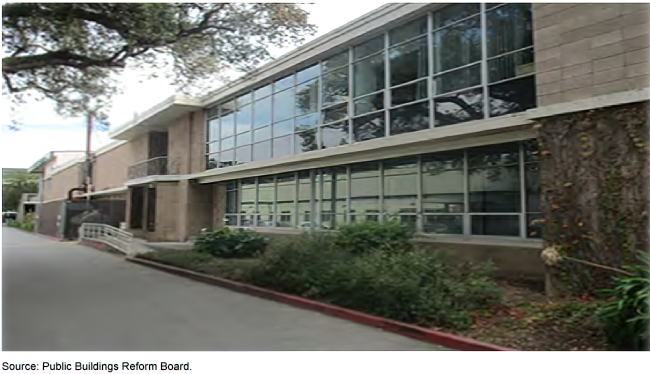Federal Real Property: Lessons Learned from Setbacks in New Sale and Transfer Process Could Benefit Future Disposal Efforts
Fast Facts
This testimony discusses how the federal government manages unneeded property—an issue on our High Risk List.
A 2016 law set up a 3-round process to select and prepare these federal buildings for sale. Proceeds from prior rounds of sales go into a fund to help pay upfront costs for the next round.
However, some participating agencies said they faced setbacks. Delays in selling 1st-round properties reduced the amount of available proceeds, limiting the number of properties in the 2nd round. We've previously recommended collecting and sharing lessons learned to help address long-standing inefficiencies in real property disposal.
An example of a property in Menlo Park, California, listed for sale in 2022

Highlights
What GAO Found
The Federal Assets Sale and Transfer Act of 2016 (FASTA) established a new, temporary three-round process for reducing the federal government's inventory of federal civilian real property. Stakeholders in this process include the temporary Public Buildings Reform Board (Board), the General Services Administration (GSA), the Office of Management and Budget (OMB), and selected federal agencies. Stakeholders told GAO they had encountered numerous setbacks while implementing the first two rounds and identified potential options to address those setbacks in the final 2024 round. For example:
- Delays selling properties. Although 10 unneeded properties have sold so far, for a total of $194 million, it took almost 2 years to sell any of the properties OMB approved for disposal during the first round in 2019. According to stakeholders, the delays were due, in part, to an evolving sales strategy.
- Limited Board recommendations. Sales proceeds generated from prior rounds are intended to fund costs associated with implementing OMB-approved Board recommendations in subsequent rounds, pending congressional appropriation. According to Board officials, the lack of sales proceeds deposited and appropriated from the first round limited the number, value, and complexity of properties it could recommend for disposal in the second round in 2021.
Stakeholders told GAO that committing to a sales strategy early in the process and examining the deadlines under FASTA could help mitigate some of the setbacks encountered in prior rounds.
As of May 2023, GSA has taken some actions to collect lessons learned, but has not yet fully implemented GAO's October 2022 recommendation to develop a lessons learned process. GSA has collected initial lessons learned from the implementation of FASTA including a discussion of underlying assumptions, structural issues, and challenges implementing the FASTA process. GSA solicited and incorporated feedback from the Board regarding its initial list of lessons learned. GSA also requested but has not received input from OMB. However, GSA still does not have a process for continuing to work with stakeholders to collect, share, and apply lessons learned. To make the final FASTA round a success—and to identify concepts that could improve future real property disposal efforts and any potential reforms—stakeholders' will need to leverage knowledge and experiences from the first two rounds of FASTA. Identifying efficient methods and reliable utilization data for disposal of federal real property is especially important in the aftermath of the COVID-19 pandemic, as competition for federal funds remains high and agencies' space requirements continue to evolve.
Why GAO Did This Study
Federal agencies face long-standing challenges in disposing of unneeded real property. These challenges include lengthy disposal processes related to statutory and regulatory requirements, a lack of upfront funding, and limitations on data used to identify excess and underutilized properties. FASTA tests several concepts designed to mitigate these issues and potentially address inefficiencies in real property disposal.
This statement discusses: (1) progress made in the implementation of FASTA; (2) options to mitigate setbacks identified by stakeholders; and (3) actions GSA has taken to identify and share lessons learned.
This statement is based primarily on GAO's October 2022 report on the implementation of FASTA (GAO-23-104815). In addition, this statement provides an update on the actions that GSA has taken in response to GAO's recommendation.
Recommendations
GAO made one recommendation in its October 2022 report, that GSA, in consultation with relevant stakeholders, develop a process to collect, share, and apply lessons learned from the implementation of FASTA, including reporting any lessons learned to Congress. As of May 2023, this recommendation has not yet been fully implemented.
